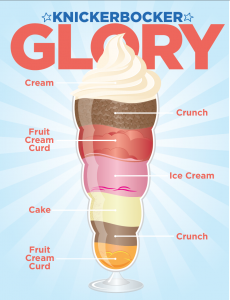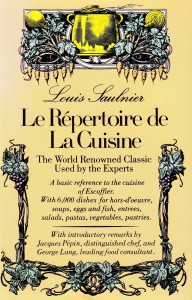With so many recipes out in the world it can seem like everything has been done before, but it hasn’t been. There is more that can be done. When we wish to be innovative sometimes it is best to have a clear statement of purpose with a starting point that is a little vague. Then, by adding a variety of interesting inspiration (also called stimulus) we can create many new WOW moments.
In cooking these vague starting points are called basic recipes. What is a basic recipe? You have no doubt seen them before. It is simply a ratio of ingredients in a dish – 1 part X, 2 Parts Y, etc. The most famous used is probably vinaigrette – 1 part acid + 2 parts oil. This can be taken to the next level – 1 part acid + 2 parts oil + goodies – where the goodies are herbs or spices. With just this, tons  of different and new vinaigrettes can be created. The basic recipe also contains some basic instructions on how to create the dish. This could come in many forms. The graphic of The Knickerbocker Glory, the dessert for which this blog is named after, is a basic recipe of sorts. It spells out how one might layer different items to create a great dessert.
of different and new vinaigrettes can be created. The basic recipe also contains some basic instructions on how to create the dish. This could come in many forms. The graphic of The Knickerbocker Glory, the dessert for which this blog is named after, is a basic recipe of sorts. It spells out how one might layer different items to create a great dessert.
Sometimes we have these basic recipes in our heads and we use them when we are cooking with reckless abandon, not really stopping to measure out the mushrooms for our stew or garlic for our salsa. It is easy to go off recipe and that is when cooking becomes really fun! While it may not seem like there is a readily available source of these basic recipes, there actually is one. It was built for another intent, but we can repurpose the information and use the basic recipes as starting points for our own innovation practice and activities.
In 1914 Louis Saulnier published a book called Le Repetoire de La Cuisine. His intent was to create short versions of the recipes written by the great culinarian August Escoffier.

A great book for basic recipes. And not just for experts! For innovators and everyone! Tweet! #Louis Salnier
Here is an example of a basic recipe from Le Repetoire…
Fricadelles – Two parts cooked meat mixed with one part mashed potatoes, cooked chopped onions, chopped parsley, egg season and mix together. Shape and cook. Serve with vegetable puree and highly seasoned sauces.
These recipes offer two great things for the innovator. First, as a starting point, it is a little vague so there is plenty of opportunity, with interesting stimulus, to create something new and different. A lot can be done with it. Second, it still has some structure to follow and has some boundaries (should you choose to heed them!) built in. For example, it says serve with vegetable puree, not fruit. It is a simple example, but it helps keep some focus on what is to be accomplished. Limits and concrete scope are good for the innovator as it keeps things from being totally ambiguous. Some ambiguity is good, too much is not.
With this recipe there are tons of ways to be innovative. We do not need to know what Mr. Escoffier or Mr. Saulnier intended either, we can just use these recipes as a starting point of a new WOW moment. We really do not need any deep skill or expertise either. We can then hunt for some stimulus to help us create our dish. Perhaps we want a thanksgiving feel to our dish so turkey and turkey sausage (who said the cooked meat couldn’t be closely related?) are chosen. The mashed potatoes used are sweet potatoes, cooked onion could still work if they are cooked until caramelized. Season with a little nutmeg, salt and pepper, bind with egg. Shape like a patty and sauté or bake. Of course, we could take this to the next level and season some bread crumbs with some chili powder and brown sugar, dredge the turkey and sweet potato fricadelles and pan-fry them. And the vegetable puree? The sky is the limit here. A fricadelle may be a main course, but what if we turned it into a sandwich? A cranberry mayonnaise could be considered.
Our basic recipe goes on and on. If our stimulus was different, not thanksgiving but vegan, our basic recipe still gives us good guidance and lots of room to bring something new to life. In a vegan fricadelle the meat is replaced with crumbled firm tofu and crumbled soft tofu for texture variation (we could even marinate this for extra flavor). Instead of potato and egg, we bind with hummus and chunks of avocado. The hummus is Mediterranean so the seasoning is simple, lemon, garlic and black pepper. Patties are shaped, dredged in breadcrumb with crushed pine nuts then pan-fried. The basic recipe does call for heavily seasoned sauces – plain soy yogurt with spicy sambal, plain soy yogurt with mint and cucumber, or simply olive oil and oregano. What if we used a pureed vegetable as a sauce?
The dishes may not be perfect the first time they are cooked, but part of innovating is iterating until WOW!
With a simple basic recipe the sky is the limit. A starting point that is a bit vague but still has some structure is a great place to begin when innovating in the kitchen. Adding some stimulus or inspiration to give to the ideas direction – like thanksgiving feel, Asian or vegan – and you will be off and running.
And, when you are done, you can tweet your friends the basic recipe. Thank you Mr. Saulnier!
Keep Eating! Keep Innovating!
Do you have a basic recipe you use often? What have you created? Let us know all about it in the comments or on Facebook.
The Culinary Exchange can also be found on Twitter, Instagram, Pinterest, Google+ and YouTube.
Come on! Follow Along!




